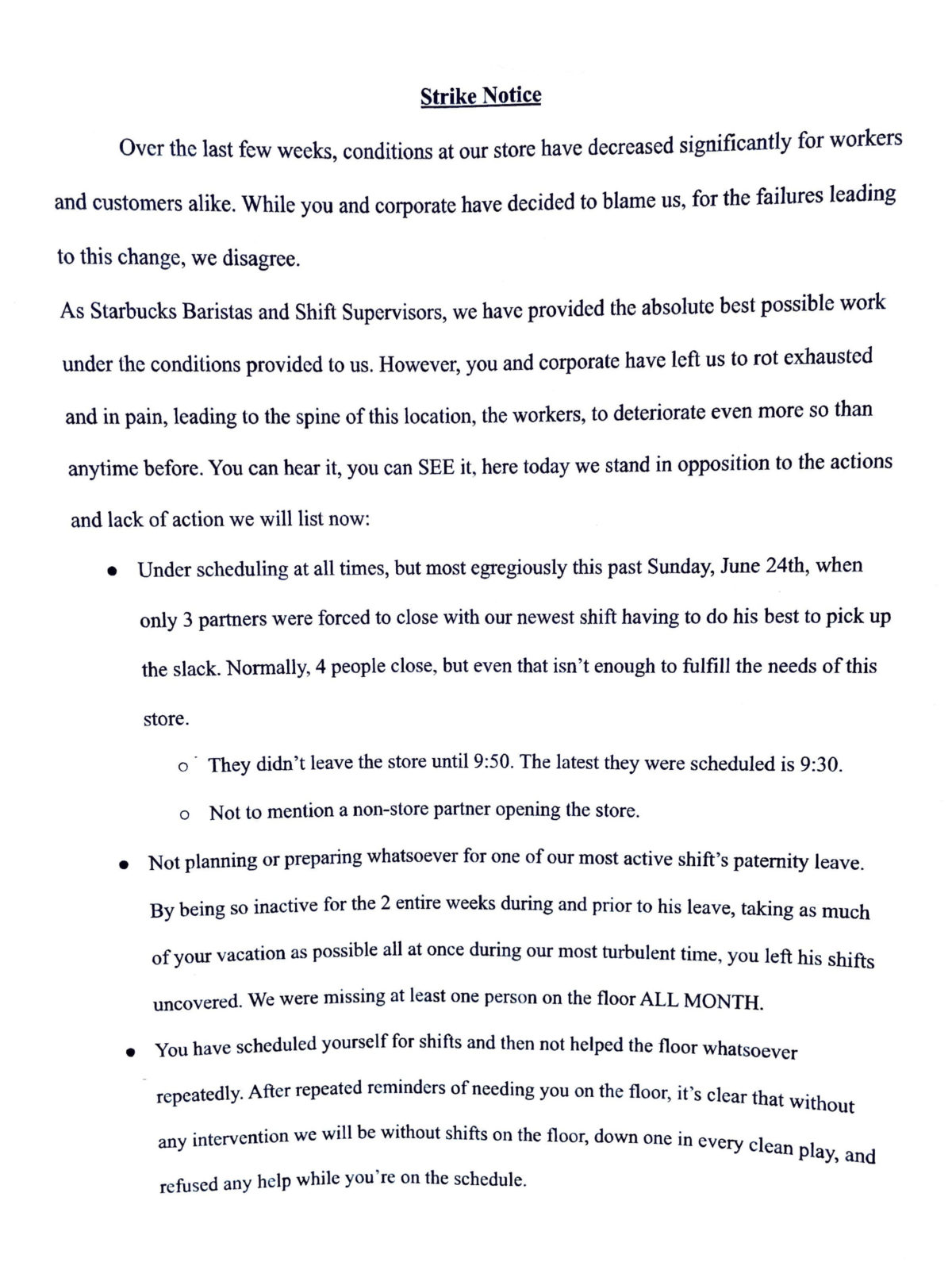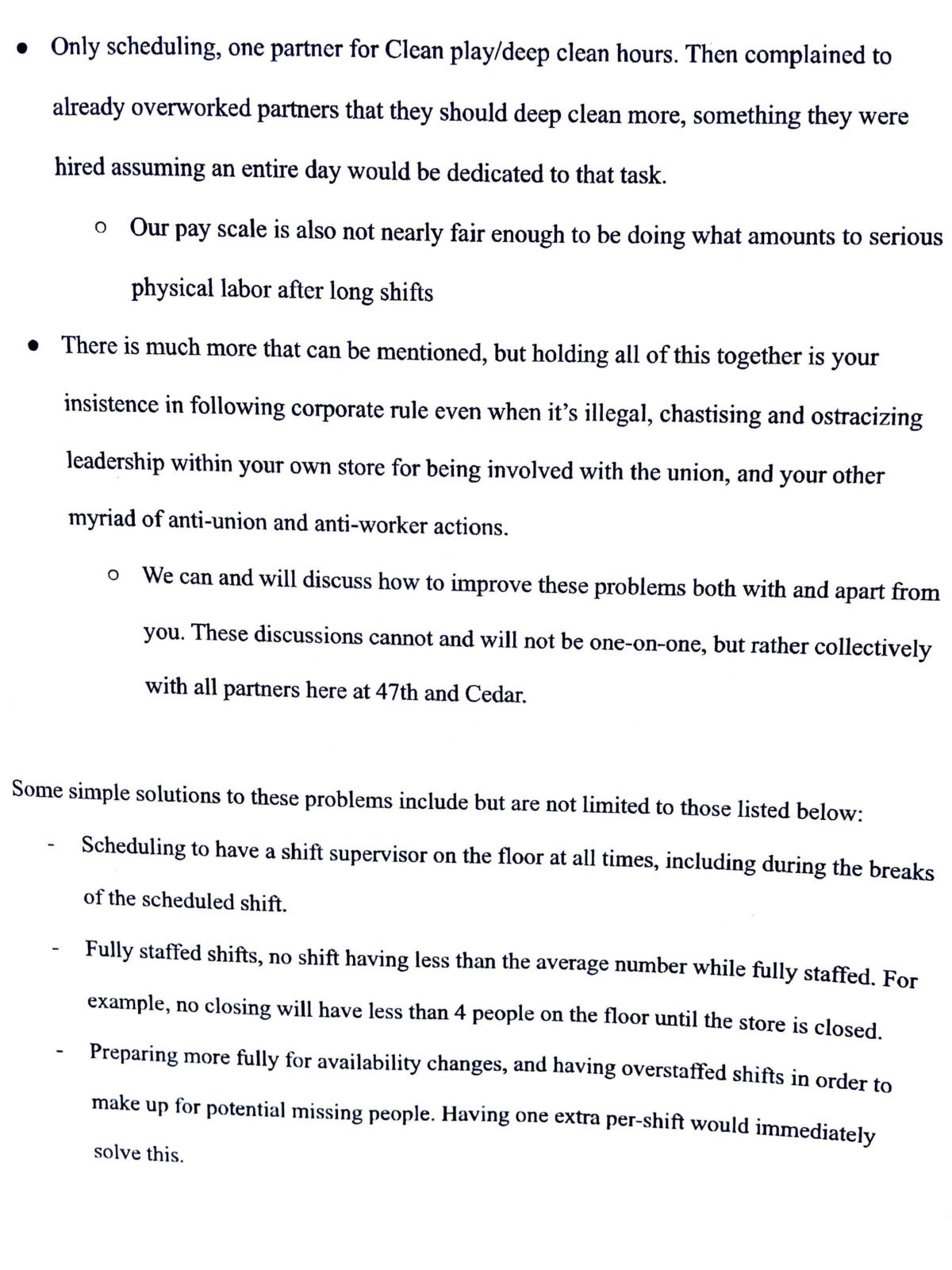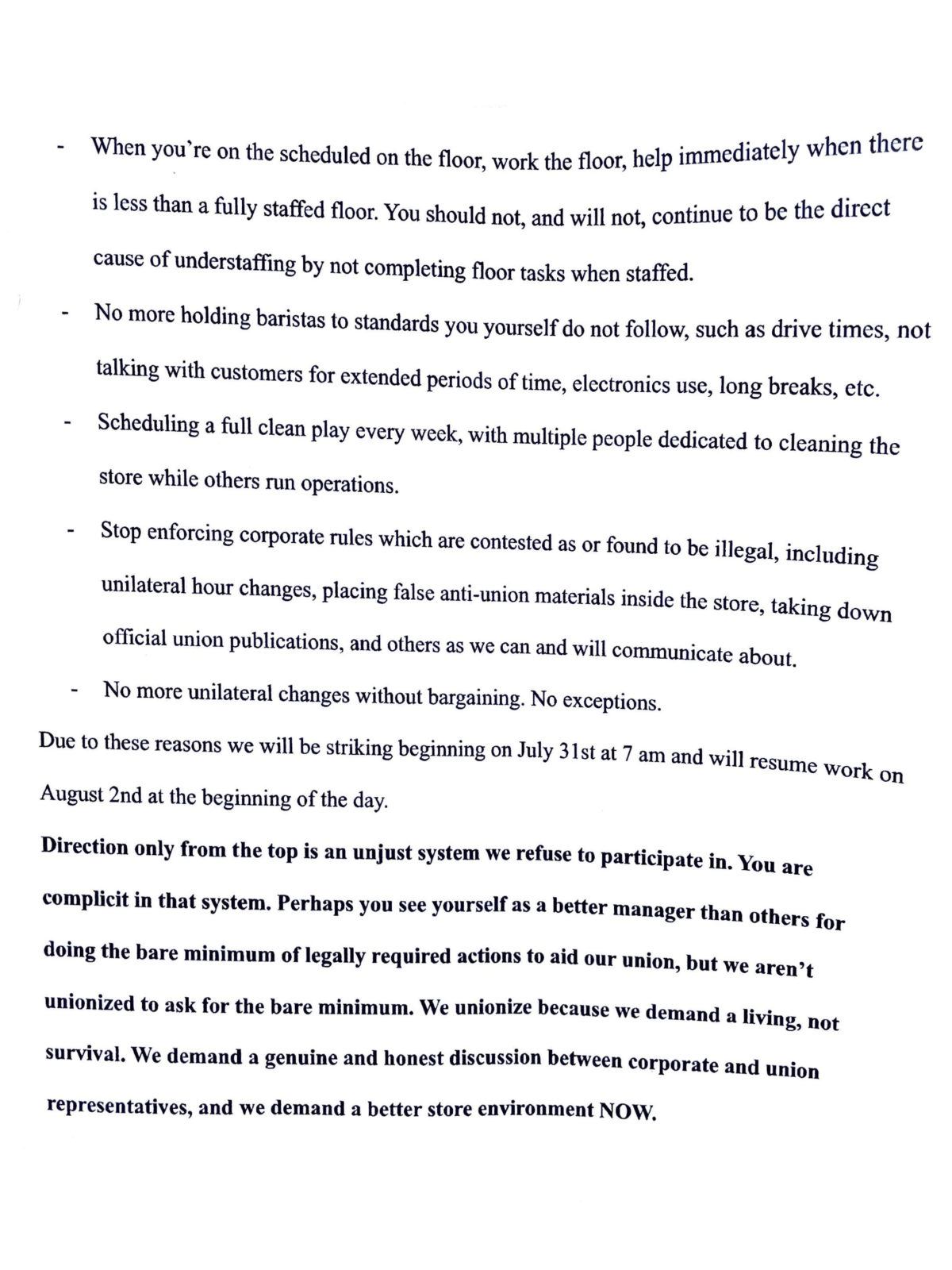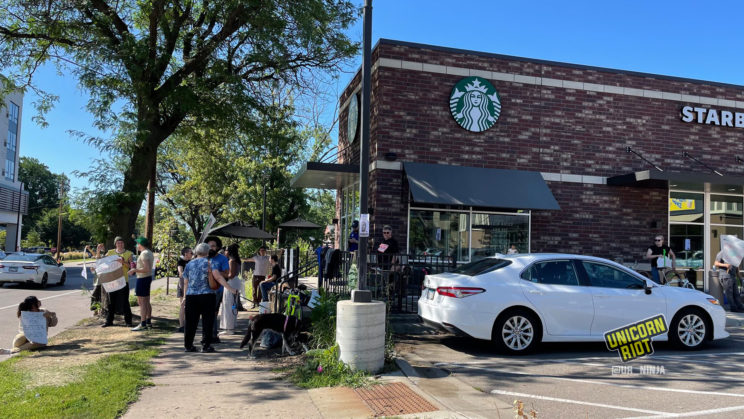Recently Unionized Minneapolis Starbucks Workers Conduct Two-day Strike
Minneapolis, MN – The corner of 47th Street and Cedar Avenue in Minneapolis was quiet for the first time after spirited drumming and chants of, “What’s disgusting? Union busting!” filled the air from July 31-August 1. Employees of the Cedar Avenue Starbucks had returned to work after a two-day strike in protest of the company’s refusal to bargain with the newly formed union, as well as what the workers say are backhanded attempts to undermine union efforts.
Baristas and shift supervisors united to raise grievances against the manager of the location and Starbucks corporate for difficult working conditions and low pay. In a letter posted on the front door of the store, workers addressed their manager:
“Direction only from the top is an unjust system we refuse to participate in. You are complicit in that system. Perhaps you see yourself as a better manager than others for doing the bare minimum of legally required actions to aid our union, but we aren’t unionized to ask for the bare minimum. We unionize because we demand a living, not survival. We demand a genuine and honest discussion between corporate and union representatives, and we demand a better store environment NOW.”
Letter from Starbucks’ workers
Below are pictures of the ‘Strike Notice’ that was posted on the front door of the Minneapolis Starbucks by the unionized workers.



Understaffing and inconsistent scheduling practices have been a recurring issue at the store, according to workers, though they say it has escalated in recent months. Kasey Copeland, a Starbucks barista and trainer of three years, said:
“Generally, when we’re really busy, we have two to three partners on the bar. There have been several days that someone has been the only person on the bar. Imagine one barista making every single drink for every single person that comes here for hours. It’s exhausting. We’re burnt out.”
Kasey Copeland, barista and trainer
Copeland and her colleagues alleged that Starbucks continually expects each employee to pick up the work that used to be allocated to multiple people, often leaving them with no choice but to stay past the end of their shift, while Starbucks sidesteps the bargaining structure required by U.S. labor law.
Unionization Wave Reached Minneapolis Location in May
The Cedar Avenue Starbucks joins a fast-growing number of unionized Starbucks locations, jumpstarted by the first unionized store in Buffalo, N.Y. in December of 2021. Since then, 318 stores nationwide have filed to unionize through Starbucks Workers United, an SEIU affiliate. Two hundred and nineteen of those stores voted to approve the union, 46 have rejected it, and the rest have elections in progress.
In May, the Cedar Avenue store voted 14-3 to unionize. Shortly thereafter, workers said the conditions declined even further from what they had come to expect in terms of staffing numbers and scheduling issues. The store’s opening was shifted 30 minutes later on weekends after most of the morning shift employees joined the organizing committee, shortening the morning shifts. Certain employees were taken off the schedule outright for days at a time.
Though similar unilateral decisions from management have gone uncontested before, the difference this time is that workers had a newfound familiarity with their protections under the National Labor Relations Act (NLRA). In the wake of their unionizing effort, as Copeland said, “Maybe it’s just a coincidence, but it’s a lot of coincidences, you know?”
Additionally, as outlined in the NLRA, it is the responsibility of both employers and employees to “confer in good faith with respect to wages, hours, and other terms and conditions of employment.” Once the employees are represented by a labor organization, Starbucks may not make unilateral decisions around things like store hours and hiring practices without a bargaining process, actions which employees at the Cedar Avenue store say have continued, and even escalated, since the union formed.
The strike was planned to last only two days because of Starbucks’ retaliatory responses to organized stores during the union push of the past several months. Emily Mahoney, a shift supervisor who has worked with the company for five years, said the main reason behind the strategy of a contained strike is to avoid firings:
“We don’t want anybody to get fired. Legally, if we say we’re striking over an unfair labor practice—here’s where we’re starting, here’s where we’re ending—that’s just less retaliation against everybody. We’ve seen other folks get fired in more high profile stores, and that makes people a little nervous.”
Emily Mahoney, shift supervisor

National Anti-Union & Anti-Worker Policies
Starbucks, founded in 1971, is currently led by CEO Howard Schultz, who has a net worth of $4 billion and a decades-long record of anti-union business practices. The store in Buffalo, NY was not the first to move towards unionization. The company fought union drives in the past: Seattle in 1985, New York City in 2004, Philadelphia in 2019.
In 2019, workers at a Philadelphia Starbucks location began a union drive, only to be discharged from their positions after the company “closely monitored their public social media activity, attempted to gauge employees’ support for the employees’ efforts, and unlawfully spied on protected conversations one of the employees initiated with coworkers,” according to a 2021 NLRB ruling in favor of the baristas. Though the company was penalized for unlawful union retaliation in the 2019 effort, this most recent wave of worker organizing has faced more subtle pushback from Starbucks Corporate.
In October 2020, Unicorn Riot reported on a Starbucks at 1900 Market St. in Philadelphia where an employee filed a complaint with the NLRB alleging she was punished with a reduction in hours for organizing a strike and was told not to discuss working conditions with her coworkers.
Schultz said in a town hall this spring that Starbucks is “being assaulted in many ways by the threat of unionization” and that employees should have no need for a union at a company that listens so well to their needs.
“Schultz refers to the union as like an outside force that’s coming in,” Copeland said. “Actually, it’s your five year, your ten year partners who are out here saying enough is enough. The longer people have been here, the easier it is to convince them.”
Starbucks has started to close down stores in several major cities that are in various stages of organizing, including Washington, D.C. and Seattle. The company cites safety concerns as the reason behind the closures, though many workers and union representatives say that the move is a thinly veiled attempt to discourage union activity.
To further subdue union efforts, Starbucks announced in May that all tenured employees will receive a wage increase and enhanced training. However, because the NLRA prohibits unilateral decision-making at unionized stores, the company said these benefits will not apply to union employees without a bargaining process.
Starbucks is currently facing complaints of over 200 violations of the NLRA, including one from a Minneapolis location, 5351 Lyndale Ave S., filed on July 18 alleging coercive actions and statements restricting employees’ right to self-organization.
For now, workers at the Cedar Avenue store said all their energy is focused on bringing Starbucks management to the negotiating table to sign a contract that will ensure sustainable working conditions and equitable pay. “It’s hard to even fathom a world where we won’t all be struggling for money anymore,” Copeland said.
“Ideally, we won’t be flat broke every week on Saturday after our check came out Friday, because we had to pay all of our bills. And that’s definitely a longer and bigger fight. But I think this is an important step. I do think that forcing [Schultz] to pay people at least enough that they can afford to live would be ideal. It’s the bare minimum that they owe us at this point. Honestly, we make them all of their money.”
Kasey Copeland, barista and trainer
Even with their tightly focused demands, both Copeland and Mahoney said that the scope of the movement they have entered is important to them. “When the next strike happens, whoever it is, we will show up, because they’ve all shown up for us, like you see today, with all these people out here,” Copeland said.
In the days since the strike ended, workers say that they have seen very little change. The new store schedule has remained in effect, and they still struggle to adequately fill the shifts. Copeland said that their manager reached out to them to address the week that they were removed from the schedule directly following the strike, claiming it was an accidental oversight. Still, they said tensions with the store’s manager and corporate Starbucks are running high as a result of how they handled the strike, along with the continued poor daily working conditions.
Mahoney said that while the days on the picket line brought hope and inspiration for what is possible to the members of their union, workers are prepared for a scenario in which the initial strike is not enough for Starbucks to negotiate for a fair contract. “I think it’s going to take a couple more [strikes],” she said. “There are a few more stores in the country that are on strike right now. All of us working together on that really large scale is what is going to help.”
Copeland added, “I’m hoping Starbucks makes the right choice and comes to the bargaining table. But so far, my hopes have been in vain. I imagine we might end up out here again.”
Follow us on X (aka Twitter), Facebook, YouTube, Vimeo, Instagram, Mastodon, Threads, BlueSky and Patreon.
Please consider a tax-deductible donation to help sustain our horizontally-organized, non-profit media organization:



